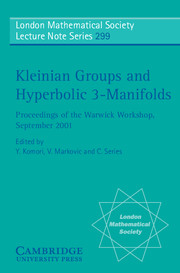 Kleinian Groups and Hyperbolic 3-Manifolds
Kleinian Groups and Hyperbolic 3-Manifolds Complex angle scaling
from Part III - Related topics
Published online by Cambridge University Press: 10 September 2009
Summary
Abstract
We introduce the method of complex angle scaling to study deformations of hyperbolic structure. We show how the method leads to a construction of counterexamples to the equivariant K = 2 conjecture for hyperbolic convex hulls.
Introduction
Our purpose is to give an exposition of the theory of complex angle scaling. Complex angle scaling mappings are quasiconformal homeomorphisms or locally injective quasiregular developing mappings of ℍ2 into or onto 2. In many cases, complex angle scalings are continous analogues of the complex earthquakes described by McMullen [McM98]. The mappings are also closely related to “quakebends” introduced in [EM87]; these are mappings ℍ2 → ℍ3.
In the form described here our theory applies to finite or infinite discrete measured laminations in hyperbolic 2-space ℍ2. For certain parameter values they can be defined to be quasiconformal on all 2 and they even have a natural extension to quasiconformal mappings of ℍ3.
In contrast, McMullen's complex earthquakes are defined on a finite area hyperbolic surface S as maps ℳℒ(S) → Teich(S). However for finite laminations on S, namely those which lift to infinite discrete laminations in ℍ2, both give exactly the same boundary values on ∂ℍ2 and therefore determine the same deformation of a fuchsian group covering S. Complex angle scalings do not naturally extend to the lifts of general measured laminations on S.
We will apply our theory to prove that Thurston's equivariant K = 2 conjecture does not hold.
- Type
- Chapter
- Information
- Kleinian Groups and Hyperbolic 3-ManifoldsProceedings of the Warwick Workshop, September 11–14, 2001, pp. 343 - 362Publisher: Cambridge University PressPrint publication year: 2003
